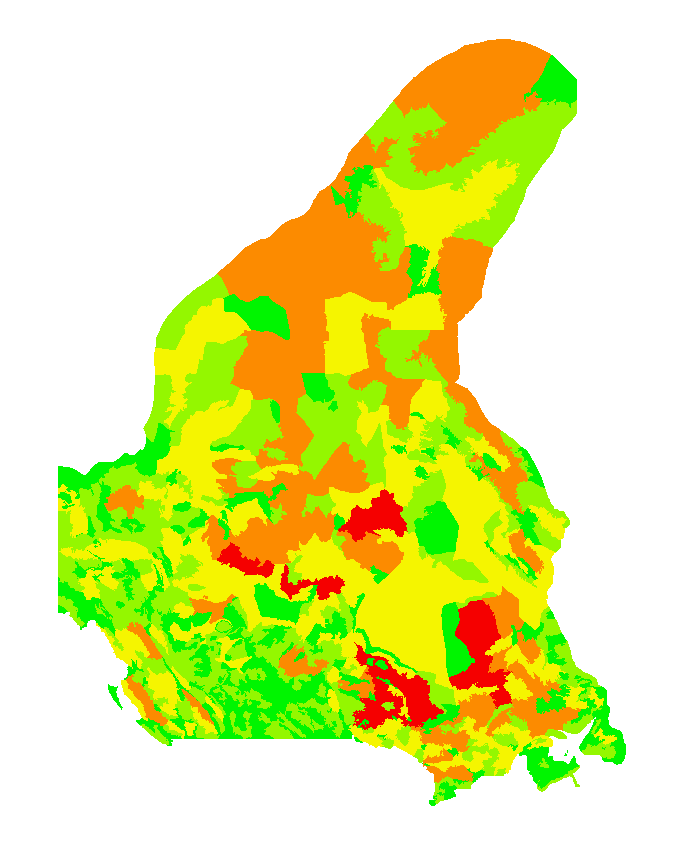Ecology
Type of resources
Available actions
Topics
Keywords
Contact for the resource
Provided by
Years
Formats
Representation types
Update frequencies
status
Service types
-

The National Ecological Framework for Canada's "Land and Water Area by Province/Territory and Ecodistrict” dataset provides land and water area values by province or territory for the Ecodistrict framework polygon, in hectares. It includes codes and their English and French descriptions for a polygon’s province or territory, total area, land-only area and large water body area.
-

The “Terrestrial Ecoregions of Canada” dataset provides representations of ecoregions. An ecoregion is a subdivision of an ecoprovince and is characterized by distinctive regional ecological factors, including climate, physiography, vegetation, soil, water, and fauna. For example, the Maritime Barrens ecoregion (no. 114) is one of nine ecoregions within the Newfoundland ecoprovince.
-

The National Ecological Framework for Canada's "Surface Material by Ecoregion” dataset provides surface material information within the ecoregion framework polygon. It provides surface material codes and their English and French language descriptions as well as information about the percentage of the polygon that the component occupies. Surface material includes the abiotic material at the earth's surface. The materials can be: ICE and SNOW - Glacial ice and permanent snow ORGANIC SOIL - Contains more than 30% organic matter as measured by weight ROCK - Rock undifferentiated MINERAL SOIL - Predominantly mineral particles: contains less than 30% organic matter as measured by weight URBAN - Urban areas. Note that only a few major urban area polygons are included on SLC source maps, therefore, do not use for tabulating total urban coverage
-

The National Ecological Framework for Canada's "Surface Form by Ecoprovince" dataset contains tables that provide surface form information for components within the ecoprovince framework polygon. It provides surface form codes and their English and French-language descriptions as well as information about the percentage of the polygon that the component occupies. Surface form descriptions describe assemblages of slopes or recurring patterns of forms that occur at the earth's surface. When applied to consolidated materials (material that has been transformed to hard rock), it refers to the form produced after modification by geological processes. The mineral soil surface forms are: dissected; hummocky (irregular); inclined; level, rolling; ridged; steep; terraced; undulating. The wetland surface forms are: bog; fen; marsh; swamp.
-

The National Ecological Framework for Canada provides a consistent, national spatial framework that allows various ecosystems to be described, monitored and reported on. It provides standard ecological units that allow different jurisdictions and disciplines to use common communication and reporting, and a common ground to report on the state of the environment and the sustainability of ecosystems in Canada. The framework was developed between 1991 and 1999 by the Ecosystems Science Directorate, Environment Canada and the Center for Land and Biological Resources Research, Agriculture and Agri-Food Canada. Over 100 federal and provincial agencies, non-governmental organizations and private sector companies contributed to its development.
-

The National Ecological Framework for Canada's "Surface Form by Ecoregion" dataset contains tables that provide surface form information for components within the ecoregion framework polygon. It provides surface form codes and their English and French-language descriptions as well as information about the percentage of the polygon that the component occupies. Surface form descriptions describe assemblages of slopes or recurring patterns of forms that occur at the earth's surface. When applied to consolidated materials (material that has been transformed to hard rock), it refers to the form produced after modification by geological processes. The mineral soil surface forms are: dissected; hummocky (irregular); inclined; level, rolling; ridged; steep; terraced; undulating. The wetland surface forms are: bog; fen; marsh; swamp.
-

The National Ecological Framework for Canada's "Soil Development by Ecoregion” dataset contains tables that provide soil development information for components within the ecoregion framework polygon. It provides soil development codes and their English and French-language descriptions as well as the percentage of the polygon that the component occupies. The soil development descriptions are based on the second edition of the Canadian System of Soil Classification (Agriculture Canada Expert Committee on Soil Survey, 1987).
-

The National Ecological Framework for Canada's "Elevation by Ecoregion” dataset provides elevation information for ecoregion framework polygons, in meters. It includes codes and descriptions for minimum elevation, maximum elevation, mean elevation and the difference in elevation.
-

The National Ecological Framework for Canada's "Permafrost by Ecoregion” dataset contains tables that provide permafrost information within the ecoregion framework polygon. It provides permafrost codes and their English and French language descriptions as well as information about the percentage of the polygon that the component occupies. Permafrost is defined as a state of the ground, whether soil or rock, that remains at or below a temperature of 0° C for long periods (NRC, Permafrost Subcommittee, 1988). The minimum period is from one winter, through the following summer, and into the next winter; however, most permafrost has existed for much longer. This formal definition considers only the temperature of the ground, and thus permafrost is a strictly thermal phenomenon, and not a material. At temperatures below 0° C , almost all of the soil moisture occurs in the form of ground ice. Ground ice usually exists at temperature close to its melting point and so is liable to melt if the ground warms. The extent and nature of permafrost, including estimated ice content and typical ground ice forms are derived from the map "Canada - Permafrost" (Natural Resources Canada, 1995).
-

The National Ecological Framework for Canada's "Surface Form by Ecozone" dataset contains tables that provide surface form information for components within the ecozone framework polygon. It provides surface form codes and their English and French-language descriptions as well as information about the percentage of the polygon that the component occupies. Surface form descriptions describe assemblages of slopes or recurring patterns of forms that occur at the earth's surface. When applied to consolidated materials (material that has been transformed to hard rock), it refers to the form produced after modification by geological processes. The mineral soil surface forms are: dissected; hummocky (irregular); inclined; level, rolling; ridged; steep; terraced; undulating. The wetland surface forms are: bog; fen; marsh; swamp.
 Arctic SDI catalogue
Arctic SDI catalogue